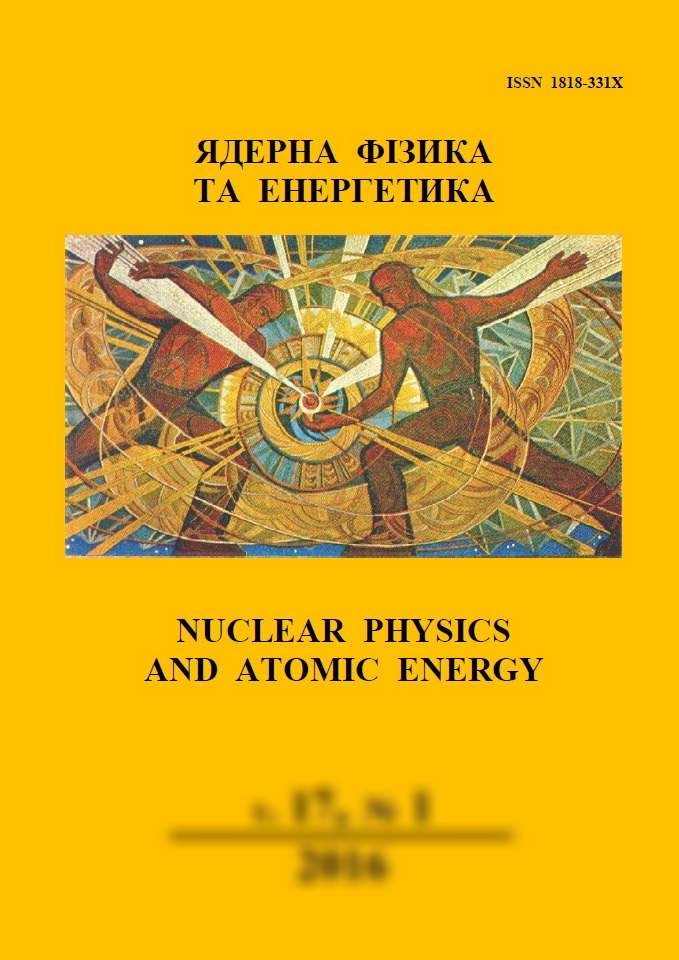 |
Ядерна фізика та енергетика
Nuclear Physics and Atomic Energy
ISSN:
1818-331X (Print), 2074-0565 (Online)
Publisher:
Institute for Nuclear Research of the National Academy of Sciences of Ukraine
Languages:
Ukrainian, English
Periodicity:
4 times per year
Open access peer reviewed journal
|
Nucl. Phys. At. Energy 2023, volume 24, issue 2, pages 87-92.
Section: Nuclear Physics.
Received: 30.12.2022; Accepted: 09.05.2023; Published online: 19.06.2023.
 Full text (en)
Full text (en)
https://doi.org/10.15407/jnpae2023.02.087
Space-time picture and observables in heavy ion collisions at the Large Hadron Collider energies
Yu. M. Sinyukov1,2,*, V. M. Shapoval1, M. D. Adzhymambetov1
1 Bogolyubov Institute for Theoretical Physics, National Academy of Sciences of Ukraine, Kyiv, Ukraine
2 Warsaw University of Technology, Warsaw, Poland
*Corresponding author. E-mail address:
sinyukov@bitp.kiev.ua
Abstract:
In the present work, we combine and systemize the results of our recent research activity aiming to reveal the spatiotemporal structure of those extremely hot, dense, and rapidly expanding systems, which form in ultrarelativistic heavy ion collisions, as well as to reproduce in computer simulations the experimentally measured bulk observables. The latter include hadronic yields, particle number ratios, transverse momentum spectra, νn coefficients, and the femtoscopy scales, calculated for different collision energies within the integrated hydrokinetic model. We investigate how our simulation results depend on the model tuning, in particular, the utilized equation of state for quark-gluon matter and discuss the effect of the post-hydrodynamic stage of the system's evolution on the observables formation.
Keywords:
ultrarelativistic heavy ion collisions, particle yields, transverse momentum spectra, femtoscopy scales.
References:
1. S.V. Akkelin, Yu.M. Sinyukov. The HBT-interferometry of expanding sources. Phys. Lett. B 356 (1995) 525.
https://doi.org/10.1016/0370-2693(95)00765-D
2. R. Lednicky, V.L. Lyuboshitz. Final State Interaction Effect on Pairing Correlations Between Particles with Small Relative Momenta. Sov. J. Nucl. Phys. 35 (1982) 770.
3. V.Yu. Naboka et al. Initialization of hydrodynamics in relativistic heavy ion collisions with an energy-momentum transport model. Phys. Rev. C 91 (2015) 014906.
https://doi.org/10.1103/PhysRevC.91.014906
4. V.Yu. Naboka, Iu.A. Karpenko, Yu.M. Sinyukov. Thermalization, evolution, and observables at energies available at the CERN Large Hadron Collider in an integrated hydrokinetic model of A + A collisions. Phys. Rev. C 93 (2016) 024902.
https://doi.org/10.1103/PhysRevC.93.024902
5. W. Broniowski, M. Rybczyński, P. Bożek. GLISSANDO: GLauber Initial-State Simulation and mOre… Comput. Phys. Commun. 180 (2009) 69.
https://doi.org/10.1016/j.cpc.2008.07.016
6. S.A. Bass et al. Microscopic models for ultrarelativistic heavy ion collisions. Prog. Part. Nucl. Phys. 41 (1998) 255.
https://doi.org/10.1016/S0146-6410(98)00058-1
7. V.M. Shapoval, Yu.M. Sinyukov. Bulk observables in Pb + Pb collisions at √SNN = 5.02 TeV at the CERN Large Hadron Collider within the integrated hydrokinetic model. Phys. Rev. C 100 (2019) 044905.
https://doi.org/10.1103/PhysRevC.100.044905
8. M.D. Adzhymambetov, V.M. Shapoval, Yu.M. Sinyukov. Description of bulk observables in Au + Au collisions at top RHIC energy in the integrated hydrokinetic model. Nucl. Phys. A 987 (2019) 321.
https://doi.org/10.1016/j.nuclphysa.2019.04.013
9. Yu. Sinyukov, M. Adzhymambetov, V. Shapoval. Particle Production in XeXe Collisions at the LHC within the Integrated Hydrokinetic Model. Particles 3 (2020) 114.
https://doi.org/10.3390/particles3010010
10. ALICE Collaboration. Transverse momentum spectra and nuclear modification factors of charged particles in Xe-Xe collisions at √SNN = 5.44 TeV. Phys. Lett. B 788 (2019) 166.
https://doi.org/10.1016/j.physletb.2018.10.052
11. J. Adam et al. (The ALICE Collaboration). Anisotropic Flow of Charged Particles in Pb-Pb Collisions at √SNN = 5.02 TeV. Phys. Rev. Lett. 116 (2016) 132302.
https://doi.org/10.1103/PhysRevLett.116.132302
12. J. Adams et al. (STAR Collaboration). Scaling Properties of Hyperon Production in Au + Au Collisions at √SNN = 200 GeV. Phys. Rev. Lett. 98 (2007) 062301.
https://doi.org/10.1103/PhysRevLett.98.062301
13. M. Laine, Y. Schröder. Quark mass thresholds in QCD thermodynamics. Phys. Rev. D 73 (2006) 085009.
https://doi.org/10.1103/PhysRevD.73.085009
14. A. Bazavov et al. (HotQCD Collaboration). The equation of state in (2+1)-flavor QCD. Phys. Rev. D 90 (2014) 094503.
https://doi.org/10.1103/PhysRevD.90.094503
15. A. Andronic, P. Braun-Munzinger, J. Stachel. Thermal hadron production in relativistic nuclear collisions. Acta Phys. Polon. B 40 (2009) 1005.
https://www.actaphys.uj.edu.pl/fulltext?series=Reg&vol=40&page=1005
16. J. Stachel et al. Confronting LHC data with the statistical hadronization model. J. Phys.: Conf. Ser. 509 (2014) 012019.
https://doi.org/10.1088/1742-6596/509/1/012019
17. F. Bellini (for the ALICE Collaboration). Testing the system size dependence of hydrodynamical expansion and thermal particle production with π, K, p, and φ in Xe-Xe and Pb-Pb collisions with ALICE. Nucl. Phys. A 982 (2019) 427.
https://doi.org/10.1016/j.nuclphysa.2018.09.082
18. D.S.D. Albuquerque (for the ALICE Collaboration). Hadronic resonances, strange and multi-strange particle production in Xe-Xe and Pb-Pb collisions with ALICE at the LHC. Nucl. Phys. A 982 (2019) 823.
https://doi.org/10.1016/j.nuclphysa.2018.08.033
